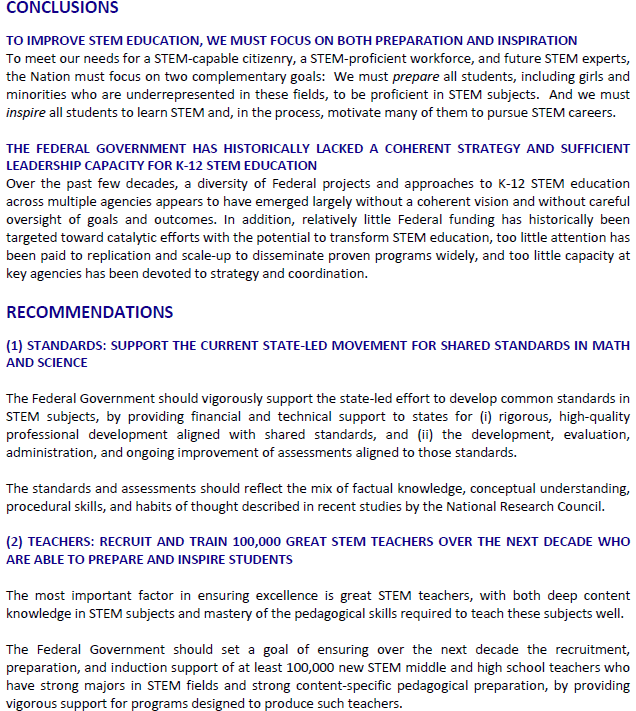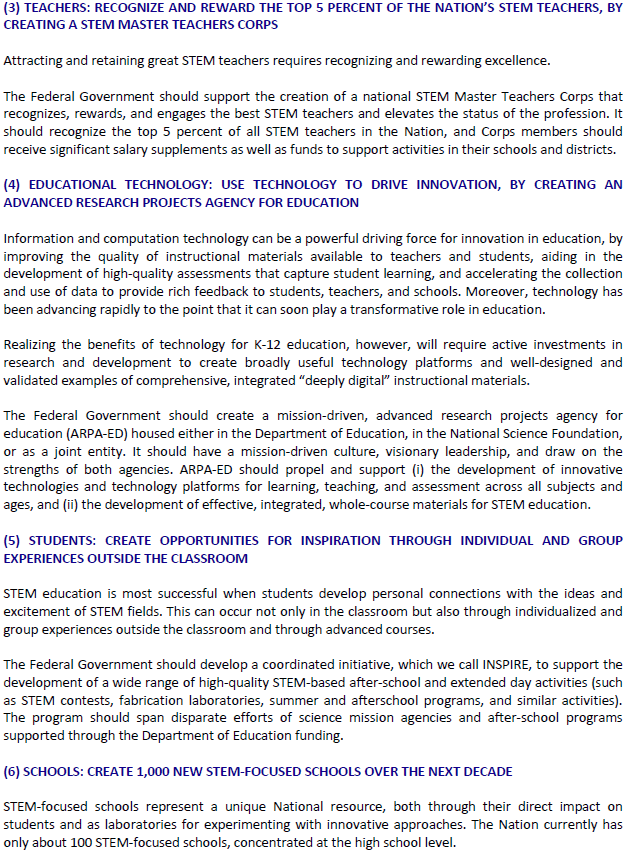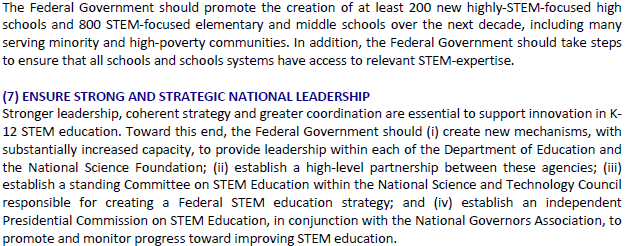|
|
|
|
|
|
|
News & Views item - September 2010 |
![]() Presidentís Council of Advisers on Science and Technology (PCAST)
Releases Report on STEM Education. (September 17, 2010)
Presidentís Council of Advisers on Science and Technology (PCAST)
Releases Report on STEM Education. (September 17, 2010)
The Presidentís Council of Advisers on Science and Technology (PCAST) yesterday delivered to President Obama its recommendations on what the federal government must implement in order to improve to the teaching in primary, middle and high schools of science, technology, engineering and maths (STEM).
Titled
Prepare and Inspire: K-12 Education in Science, Technology,
Engineering, and Math (STEM) for Americaís Future![]() ,
the 130-page report was approved at PCAST's September 2nd meeting.
,
the 130-page report was approved at PCAST's September 2nd meeting.
| President Obama announced today the creation of a non-profit organization established to improve science, technology, engineering and math education. The group, led by the chief executives of Xerox, Time Warner Cable and Eastman Kodak, is tasked with expanding science camps for girls, improving professional development for math teachers, encouraging social groups that are traditionally underrepresented to enter these fields and increasing the number of students in robotics competitions and Advanced Placement math and science courses. |
In their covering letter to the US president the co-chairs of PCAST, John Holdren and Eric Lander wrote in part:
As you will see, we envision a two-pronged strategy for transforming K-12 education. We must prepare students so they have a strong foundation in STEM subjects and are able to use this knowledge in their personal and professional lives. And we must inspire students so that all are motivated to study STEM subjects in school and many are excited about the prospect of having careers in STEM fields. But this report goes much further than that. It includes specific and practical recommendations that your Administration can take that would help bring this two-pronged strategy to fruition. These recommendations fall under five overarching priorities:
(1) improve Federal coordination and leadership on STEM education;
(2) support the state-led movement to ensure that the Nation adopts a common baseline for what students learn in STEM;
(3) cultivate, recruit, and reward STEM teachers that prepare and inspire students;
(4) create STEM-related experiences that excite and interest students of all backgrounds; and
(5) support states and school districts in their efforts to transform schools into vibrant STEM learning environments.
We are confident that the report provides a workable, evidence-based roadmap for achieving the vision you have so boldly articulated for STEM education in America. We are grateful for the opportunity to serve you in this way and to provide our input on an issue of such critical importance to the Nationís future.
The report notes that: "In the fall of 2009, the President asked his Presidentís Council of Advisors on Science and Technology (PCAST) to develop specific recommendations concerning the most important actions that the administration should take to ensure that the United States is a leader in STEM education in the coming decades. In responding to this charge, PCAST decided to focus initially on the K-12 level. (A subsequent report will address STEM education at community colleges, four-year colleges, and universities.)"
It then introduces its key conclusions and recommendations: "While the report discusses a range of conclusions and recommendations, we have sought to identify the most critical priorities for rapid action. Below, we summarize our two main conclusions and our seven highest priority recommendations."
____________________________________



_____________________________________________